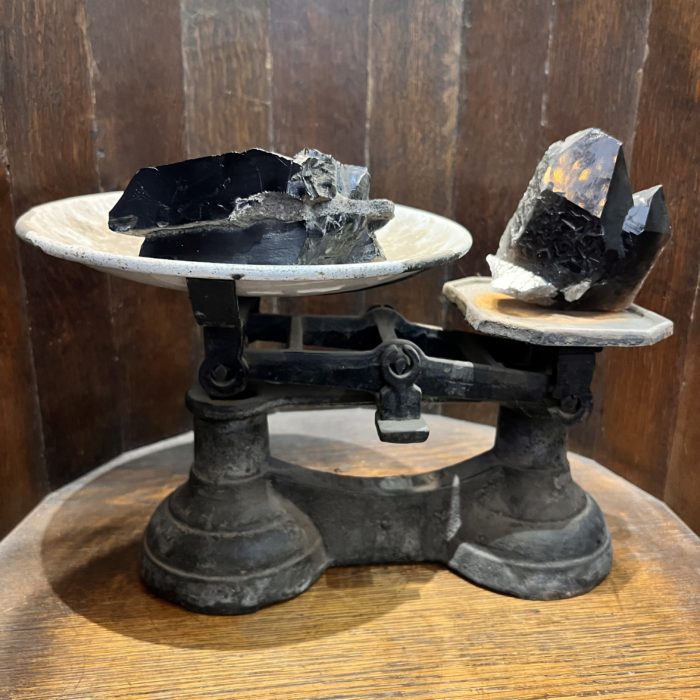10 ways to identify Whitby Jet jewellery
Sometimes we need 10 quick ways to identify Whitby jet jewellery. There is much published on the internet about how to identify jet unfortunately most of it is incorrect. Some of the tests, especially those which suggest you burn the item, are downright dangerous. For a more detailed approach check out How to identify antique Whitby jet jewellery.
No Whitby jet will be harmed in the following testing methods
Non-destructive methods for how to tell Whitby Jet jewellery
It is important that our 10 ways to identify Whitby jet testing methods are non-destructive, also destructive testing like ‘the hot needle test’ devalue the item. Only an idiot sets fire to jewellery to test it! Let’s look at how the real experts identify Whitby jet.
1) Is Whitby jet jet-black?

Jets is jet-black, after all, the clue is in the name! ‘Jet-black’ was allegedly coined by William Shakespeare in Titus Andronicus. Many jet simulants are not truly black, moreover, materials like Vulcanite are bleached by ultraviolet light so often appear a khaki colour. As I tell my students, ‘If it’s not black, put it back!’
2) Is it lightweight?
Whitby jet has a really low specific gravity. In layman’s terms, this means that Whitby jet is lightweight. If the item feels heavy, like most glass, then it is not jet. Beware however, all lightweight jewellery is not jet, it could also easily be plastic.

3) Whitby jet feels warm
Whitby jet has a low thermal conductivity. What does this mean? Well, it feels warm as the heat its wicked away from the surface very slowly, therefore if the item feels cold it is not Whitby jet. Perhaps it is a mineral species like obsidian or a glass like ‘French jet’.

4) Can you see moulding marks in Whitby jet?

Whitby jet doesn’t have moulding marks. Check around the outer circumference of your jewellery item. Can you see a seem or moulding mark as can be seen in the photo above? Whitby jet is carved not moulded consequently if you see moulding marks it is either glass or a plastic.
Are there any carving marks in Whitby jet?
Whitby jet jewellery is carved, consequently invest in a jeweller’s loupe and scrutinise your item. Can you see carving, filing or polishing marks? However good the craftsman/craftswoman there will always be evidence of carving in Whitby jet items.
5) Are there any bubbles in Whitby jet?

Whitby jet never has bubbles henceforth, bubbles in ‘jet’ items are bad news. Jet was never liquid (although it was once a jelly) and therefore there are never bubbles. However, there are jet simulants made from resin containing jet dust and as seen above, these simulants often contain bubbles. Invest in a jeweller’s loupe and scrutinise your item. Glass products will also often have bubbles.
6) Can you screw into Whitby jet?

It is not possible to screw into Whitby jet, therefore if your item is a brooch turn it over and examine the pin. Are there any screws? If there are screws it is likely to be dyed pressed horn.
7)Does Whitby jet smell funky?
Whitby jet jewellery does not smell therefore give your jewellery item a brisk rub with your fingers. Do you smell anything? Camphor, formalin, sour milk or an odour of rotten eggs are a sure sign that the item is not Whitby jet, Whitby jet has no smell when rubbed!

8) Does Whitby jet chip or decompose?
Whitby jet items do not decompose in the same way as other Victorian jet simulants. Check the edges for chips. Are the chips clean like a chip in glass? Is the chip jet-black? If so the item is more likely to be jet equally if the chip is flakey and translucent then it is not jet but dyed pressed horn.

9) Does Whitby jet have built-in hinges?

A hinge cannot be formed from jet. Therefore, the hinges are provided by metal patented mechanisms that are hidden within the body of the jet. If the hinge is formed from the body of the material however the item is very likely formed from Vulcanite a vulcanised rubber and common simulant of Whitby jet.

10) Does Whitby jet jewellery have decoration inside? Is Whitby jet polished on the back?
Whitby jet items are rarely decorated on the back although they are generally polished.

If the item is a locket there is never any moulded decoration inside, equally if you see decoration inside a piece it is likely Vulcanite. See the photo above of the Vulcanite locket.
In conclusion, we now know 10 ways to identify Whitby jet jewellery!

Most of the jewellery items I am asked to evaluate are Victorian pieces. As with all jewellery history, if you know the jewellery trends of the time you can make an educated guess as to the likely date and identity of your artefact. If you are interested in buying genuine guaranteed antique Whitby jet jewellery, head over to The Ebor Jetworks to check out our collection Where to buy antique Whitby Jet

